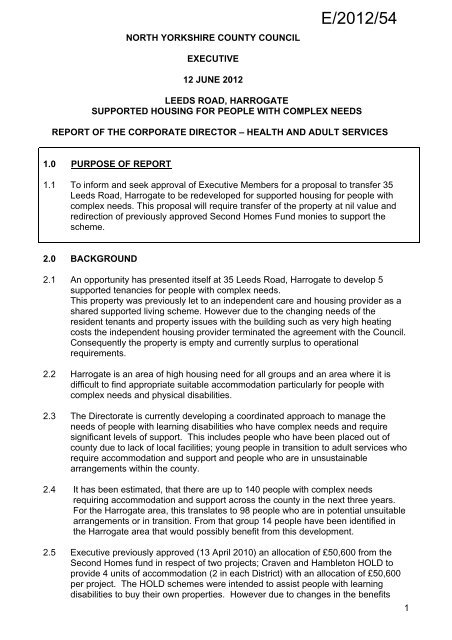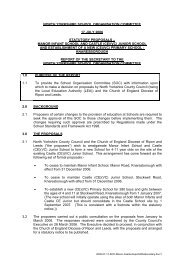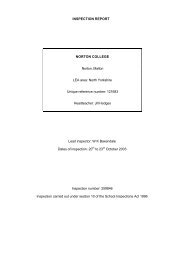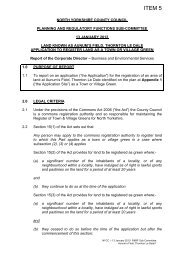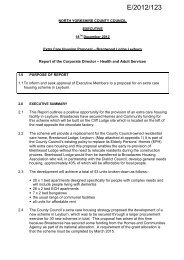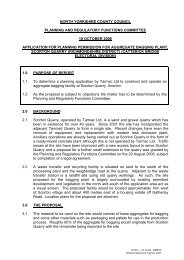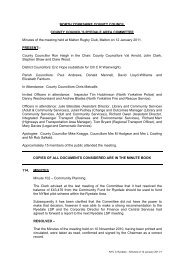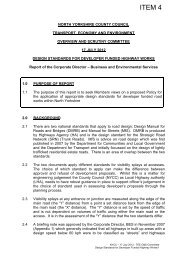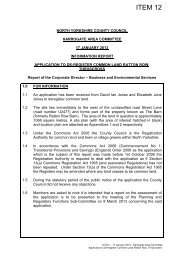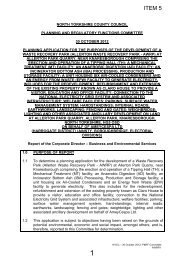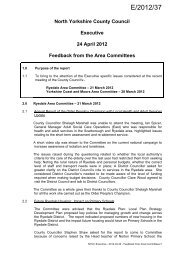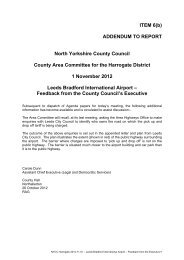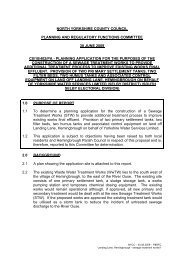Leeds Road, Harrogate - North Yorkshire County Council
Leeds Road, Harrogate - North Yorkshire County Council
Leeds Road, Harrogate - North Yorkshire County Council
Create successful ePaper yourself
Turn your PDF publications into a flip-book with our unique Google optimized e-Paper software.
NORTH YORKSHIRE COUNTY COUNCIL<br />
E/2012/54<br />
EXECUTIVE<br />
12 JUNE 2012<br />
LEEDS ROAD, HARROGATE<br />
SUPPORTED HOUSING FOR PEOPLE WITH COMPLEX NEEDS<br />
REPORT OF THE CORPORATE DIRECTOR – HEALTH AND ADULT SERVICES<br />
1.0 PURPOSE OF REPORT<br />
1.1 To inform and seek approval of Executive Members for a proposal to transfer 35<br />
<strong>Leeds</strong> <strong>Road</strong>, <strong>Harrogate</strong> to be redeveloped for supported housing for people with<br />
complex needs. This proposal will require transfer of the property at nil value and<br />
redirection of previously approved Second Homes Fund monies to support the<br />
scheme.<br />
2.0 BACKGROUND<br />
2.1 An opportunity has presented itself at 35 <strong>Leeds</strong> <strong>Road</strong>, <strong>Harrogate</strong> to develop 5<br />
supported tenancies for people with complex needs.<br />
This property was previously let to an independent care and housing provider as a<br />
shared supported living scheme. However due to the changing needs of the<br />
resident tenants and property issues with the building such as very high heating<br />
costs the independent housing provider terminated the agreement with the <strong>Council</strong>.<br />
Consequently the property is empty and currently surplus to operational<br />
requirements.<br />
2.2 <strong>Harrogate</strong> is an area of high housing need for all groups and an area where it is<br />
difficult to find appropriate suitable accommodation particularly for people with<br />
complex needs and physical disabilities.<br />
2.3 The Directorate is currently developing a coordinated approach to manage the<br />
needs of people with learning disabilities who have complex needs and require<br />
significant levels of support. This includes people who have been placed out of<br />
county due to lack of local facilities; young people in transition to adult services who<br />
require accommodation and support and people who are in unsustainable<br />
arrangements within the county.<br />
2.4 It has been estimated, that there are up to 140 people with complex needs<br />
requiring accommodation and support across the county in the next three years.<br />
For the <strong>Harrogate</strong> area, this translates to 98 people who are in potential unsuitable<br />
arrangements or in transition. From that group 14 people have been identified in<br />
the <strong>Harrogate</strong> area that would possibly benefit from this development.<br />
2.5 Executive previously approved (13 April 2010) an allocation of £50,600 from the<br />
Second Homes fund in respect of two projects; Craven and Hambleton HOLD to<br />
provide 4 units of accommodation (2 in each District) with an allocation of £50,600<br />
per project. The HOLD schemes were intended to assist people with learning<br />
disabilities to buy their own properties. However due to changes in the benefits<br />
1
egime Chevin Housing Association was unable to progress with the projects<br />
making this approach no longer an option.<br />
The proposal being outlined seeks to redirect the second homes money to partially<br />
fund the structural and refurbishment works which are essential to bring 35 <strong>Leeds</strong><br />
<strong>Road</strong> to a habitable condition for relet. In addition this maintains the original<br />
intention of the allocation.<br />
3.0 PROPOSAL<br />
3.1 The scheme would comprise 5 one bedroom, self contained units with communal<br />
space and an office. Working with Chevin Housing Association, one of our<br />
framework partners for delivering Extra Care, outline plans have been developed to<br />
bring this building up to standard and as energy efficient as possible.<br />
3.2 Indicative scheme costs have been prepared by Chevin Housing Association and<br />
the total, subject to tender, is £379k. The majority of this would be funded internally<br />
by Chevin (£278k) and the balance by redirection monies previously approved by<br />
Executive from the Second Homes Fund to Chevin (£101k).<br />
For the scheme to be financially viable the proposal requires the site be transferred<br />
to Chevin HA at nil consideration on the condition the properties are available for<br />
affordable rent. An allocations panel would ensure the <strong>County</strong> <strong>Council</strong>’s eligibility<br />
criteria was applied and the nomination rights determined by NYCC.<br />
3.3 This will result in rents of approx £83.61 per unit, per week and a weekly service<br />
charge of £25.00 per unit, per week. The rents will fall within the affordable rent<br />
levels for housing benefit purposes. Each unit will be separately metered enabling<br />
tenants to be responsible for their own utility bills, thus maximising the opportunity<br />
for independence.<br />
3.4 The support will be provided by an appropriate support provider. The selection of a<br />
support provider, appropriate commissioning model and the service specification will<br />
be set in train to meet the timetable of the scheme development, subject to<br />
Executive approval.<br />
4.0 PERFORMANCE IMPLICATIONS<br />
4.1 This proposal provides;<br />
• More options for people with complex needs to find a housing solution within<br />
<strong>North</strong> <strong>Yorkshire</strong> to be nearer networks of parents and carers.<br />
• More people to live in their own home in the community and exercise choice and<br />
control over their accommodation and management of their finances<br />
5.0 POLICY IMPLICATIONS<br />
5.1 This proposal meets the challenges in delivering supported housing in line with the<br />
objectives within the Strategic Commissioning for Independence, Well-being and<br />
Choice (2007-2022).<br />
5.2 The <strong>North</strong> <strong>Yorkshire</strong> Community Plan 2011-14 sets out three key priorities, one of<br />
which is protecting and supporting vulnerable people. The plan specifically focuses<br />
2
on “Providing older and vulnerable people with a range of choice for their<br />
accommodation, care and support needs.”<br />
5.3 Supported housing development is a vital part of delivering sustainable communities<br />
for the future in line with the Lifetime Homes Lifetime Neighbourhoods Government<br />
Policy.<br />
6.0 FINANCIAL IMPLICATIONS<br />
6.1 The financial implications of this proposal relate to the care and accommodation<br />
related costs. The accommodation costs will be recovered through weekly rents<br />
charged by Chevin Housing Association and either paid by Housing Benefit or the<br />
tenant depending on the financial position and individual circumstances of the<br />
individual.<br />
6.2 NYCC will be responsible for commissioning and quality standards of the care for<br />
those people living within the flats at 35 <strong>Leeds</strong> <strong>Road</strong>.<br />
6.3 Most of the people living within these flats will have complex needs with significant<br />
support requirements. Based on an initial assessment this may equate to 480 hours<br />
per week with waking and sleep in support at night. This could cost in the range of<br />
£389k to £436k depending on the procurement process and prevailing market rates.<br />
6.4 Detailed financial modelling has been undertaken to compare the existing costs of<br />
placements, which range from £2,780 to £1,205 per week, and the estimated cost of<br />
replacement. It is anticipated that some economies of scale could accrue from this<br />
model of delivery. Furthermore as most of these people are eligible for continuing<br />
care funding the level of savings could increase, however this is dependent upon<br />
the outcome of negotiation with <strong>North</strong> <strong>Yorkshire</strong> and York PCT.<br />
6.5 As outlined previously, within this report, to bring this property into rentable usage<br />
will require £379k of investment. The proposal is to redirect previously allocated<br />
second homes monies as well as Chevin investing £278k.<br />
6.6 By transferring the asset to Chevin at nil value the <strong>Council</strong> is forgoing a capital<br />
receipt of £550k which would otherwise have been achieved through a sale on the<br />
open market. The Directorate will repay this on an invest to save basis and repay<br />
the capital value over 10 years. Based on estimated saving for NYCC the break<br />
even point for repayment of the capital value is just over 7 years and provide the<br />
Directorate with a relatively small revenue savings each financial year.<br />
7.0 LEGAL IMPLICATIONS<br />
7.1 The <strong>Council</strong>’s Property Procedure Rules will apply as the proposal is to transfer the<br />
sites at nil value. A legal charge will be put in place to protect the <strong>Council</strong>’s interest<br />
as well as securing 100% nomination rights.<br />
7.2 The appointment of a Housing Association and other partners for supported housing<br />
projects is not a procurement in a legal sense and therefore tenders are not<br />
required.<br />
7.3 The <strong>Council</strong>’s legal powers to implement the proposals in this report are contained<br />
in The National Assistance Act 1948. The NHS and Community Care Act 1990 and<br />
the Local Government Act 2000.<br />
3
8.0 CONSULTATION UNDERTAKEN AND RESPONSES<br />
8.1 Consultation has been undertaken with operation staff in the <strong>Harrogate</strong> area to<br />
ensure that there are people with identified needs suitable for the scheme once it<br />
has been developed.<br />
8.2 There will need to be extensive consultation undertaken with people and their<br />
parents, carers or advocates identified as appropriate for the scheme at a stage<br />
following Executive approval.<br />
8.3 Normal planning procedures will apply, where the local community will have an<br />
opportunity to submit comments.<br />
9.0 IMPACT ON OTHER SERVICES/ORGANISATIONS<br />
9.1 The people likely to benefit from the scheme are people with complex needs who,<br />
by the nature of their support requirements are likely to have some level of<br />
Continuing Health Care funding as part of their package of care and support.<br />
Contractual and risk sharing discussions will take place with the PCT to develop this<br />
proposal as well as ascertaining whether joint arrangements can be developed for<br />
future scheme proposals.<br />
9.2 The proposal complies with existing <strong>Harrogate</strong> Borough <strong>Council</strong> Planning Policy in<br />
that the building is protected under Policy CFX (Community Facilities). To comply<br />
with this policy, if NYCC wished to sell the building at market value, it would firstly<br />
have to demonstrate that the previous need had ceased or met elsewhere and then<br />
market it for twelve months for an alternative use before being able to sell on open<br />
market.<br />
10. RISK MANAGEMENT IMPLICATIONS<br />
10.1 Voids: this is being unable to find a suitable person to move into the scheme if there<br />
is a vacancy. This risk is mitigated by the fact that the properties are self contained<br />
as, in the past, in shared accommodation, voids have been lengthened by the need<br />
to have people who are compatible. In addition Chevin Housing Association will<br />
take out an insurance policy which will cover rental voids for up to 12 months so this<br />
financial risk will be mitigated by this approach.<br />
10.2 Identifying people for whom the scheme is suitable: this risk is mitigated by needs<br />
information available which shows current and continuing demand for supported<br />
housing for people with complex needs.<br />
10.3 The financial risk relates to the value of care services required to safely support the<br />
5 tenants. This risk will mitigated by procurement approach which will seek to<br />
secure a care provider who is prepared to tailor the level of care provision in<br />
response to the needs of the tenants.<br />
10.4 As outlined earlier, discussions will take place with the PCT regarding a risk sharing<br />
agreement in relation to the overall scheme as well as Continuing Health Care<br />
funding.<br />
4
10.5 Close working arrangements and consultation with the community will be important<br />
to ensure those people living within 35 <strong>Leeds</strong> <strong>Road</strong> are supported and any concerns<br />
managed locally.<br />
11.0 HUMAN RESOURCES IMPLICATIONS<br />
11.1 This proposal will create employment opportunities within the independent sector for<br />
support and ancillary staff.<br />
12.0 EQUALITIES IMPLICATIONS<br />
12.1 This report represents a positive opportunity to develop services locally and provide<br />
supported accommodation with the <strong>County</strong> rather than sourcing residential support<br />
elsewhere. An equality impact assessment has been prepared for this development<br />
and is attached as Appendix 1. The EIA did not identify any adverse equality<br />
impacts. The Action Plan identifies that we will maximise the opportunities for<br />
accessible accommodation and consult with the local Learning Disability group on<br />
layout and finish. Additionally, the EIA considered alternatives to this proposal but<br />
came to the conclusion that this proposal gave the best outcomes. The proposal<br />
promotes equality of opportunity and outcomes by an increased amount of good<br />
quality, accessible, affordable supported housing for people with complex needs, in<br />
an area where this type of accommodation is very scarce. In addition, it is placed in<br />
a low risk neighbourhood, thus minimising risk of hate crime, and reasonably close<br />
to the town centre so that a range of universal services can be accessed.<br />
13. ENVIRONMENTAL IMPACTS/BENEFITS<br />
13.1 Chevin Housing Association would conduct the refurbishment scheme using their<br />
Environmental Management System and bespoke Construction Phase Plan and<br />
would seek to eradicate or minimise any negative impacts of the proposed works.<br />
13.2 Chevin Housing Association will be working to the Homes and Community’s Design<br />
and Quality guide to maximise the opportunities for sustainable elements in the<br />
scheme such as energy efficiency.<br />
14.0 COMMUNITY SAFETY IMPLICATIONS<br />
14.1 People with complex needs can sometimes be targeted in communities and subject<br />
to the risk of safeguarding issues or hate crime. This scheme is situated in a low<br />
risk neighbour hood and part of the role of the support staff will be to ensure that<br />
people are aware of any risks and work to achieve positive relations with<br />
neighbours. Additionally, the appropriate use of assistive technology will be<br />
explored to improve the tenant’s independence.<br />
5
15.0 REASONS FOR RECOMMENDATIONS<br />
15.1 This proposal is an opportunity to make use of an unused <strong>County</strong> <strong>Council</strong> asset to<br />
provide sustainable supported housing in an area of high demand for affordable<br />
housing. In addition the capital investment in the scheme will enable efficiencies to<br />
be gained in the revenue costs of support.<br />
RECOMMENDATIONS<br />
Executive Members are asked to;<br />
16.1 Approve and support the supported housing scheme for people with complex needs<br />
as outlined in the report.<br />
16.2 Agree the transfer of 35 <strong>Leeds</strong> <strong>Road</strong>, <strong>Harrogate</strong> at nil value, terms to be agreed by<br />
the Corporate Director, Finance and Central Services.<br />
16.3 To agree to £550k being repaid on an invest to save basis over 10 years, in lieu of<br />
the capital receipt that would have been achieved had the property been sold on the<br />
open market.<br />
16.4 Redirect the previously approved allocation of Second Homes funding to Chevin<br />
Housing Association of £101, 200 to contribute to this scheme.<br />
Helen Taylor<br />
Corporate Director – Health & Adult Services<br />
<strong>County</strong> Hall<br />
<strong>North</strong>allerton<br />
Tel: 01609 53 2139<br />
Author of report<br />
Avril Hunter<br />
Strategic Commissioning Manager<br />
Tel: 01609 53 6898<br />
Attached papers:<br />
Appendix 1; Equality Impact Assessment<br />
6
Appendix 1<br />
Equality Impact Assessment<br />
35 <strong>Leeds</strong> <strong>Road</strong>, <strong>Harrogate</strong><br />
If you would like this information in another language or format such as Braille, large print or<br />
audio, please contact the Communications Unit on 01609 53 2013 or email<br />
communications@northyorks.gov.uk.<br />
7
Undertaking an Equality Impact Assessment<br />
Equality Impact Assessments (EIA) should be undertaken at the business case stage when:-<br />
<br />
<br />
<br />
<br />
<br />
You are developing a new service or policy<br />
You are reviewing an existing service or policy<br />
You are proposing a change to an existing service or policy<br />
You are reviewing a service or policy carried out on behalf of the council or another organisation<br />
Your service is re-organised.<br />
They should be referenced in your final recommendations on the service changes so that decision makers can reach an informed decision<br />
on the service/policy.<br />
An EIA should cover all the social identity characteristics protected by equality legislation – referred to as ‘protected characteristics’ or<br />
equality strands. These are;<br />
<br />
<br />
<br />
<br />
<br />
<br />
<br />
<br />
<br />
Sex<br />
Sexual orientation<br />
Religion or belief<br />
Race – this include ethnic or national origins, colour and nationality<br />
Disability – including carers<br />
Pregnancy and maternity<br />
Gender reassignment<br />
Age<br />
Marital/civil partnership status<br />
There is a lot of information available to support you in completing this assessment on the EIA pages on the NYCC intranet<br />
The <strong>Council</strong> must publish your equality impact assessment and a summary will be included on the NYCC<br />
website in line with statutory requirements. Please be aware that it will become a public document.<br />
8
Name of the Directorate and Service Area<br />
Name of the service/policy being assessed<br />
Is this the area being impact assessed a<br />
Health and Adult Services<br />
Supported Housing, <strong>Leeds</strong> <strong>Road</strong>, <strong>Harrogate</strong><br />
Policy & its implementation Service<br />
Function Initiative<br />
Project x Procedure & its implementation<br />
Is this an Equality Impact Assessment for a<br />
(Note: the Equality Impact Assessment (EIA) is<br />
concerned with the policy itself, the procedures or<br />
guidelines which control its implementation and the<br />
impact on the users)<br />
How will you undertake the EIA<br />
Existing service or a policy and its implementation<br />
Proposed service or a policy and its implementation<br />
Change to an existing service or a policy and its implementation<br />
Service or Policy carried out by an organisation on behalf of NYCC<br />
Individual Officer<br />
Eg team meetings, working party, project team,<br />
individual Officer<br />
Names and roles of people carrying out the<br />
Impact Assessment<br />
Avril hunter, Strategic Commissioning Manager<br />
Lead Officer and contact details Avril Hunter 01609 536898<br />
Date EIA started 3 rd May 2012<br />
Date EIA Completed 23 rd May 2012<br />
Sign off by Service Head/ Business Unit Head<br />
Sign off by Assistant Director (or equivalent)<br />
Debbie Hogg<br />
Date of Publication of EIA<br />
Monitoring and review process for EIA<br />
LD Efficiencies Programme Board<br />
9
1. Operating Context<br />
Please consider issues around impacts (positive or negative) raised for all protected characteristics and show your evidence<br />
1.1 Describe the service/policy<br />
What does the service/policy do and how How<br />
would you describe the policy to someone who<br />
knows very little about <strong>Council</strong> Services<br />
If there is a proposal to change the service or<br />
policy, describe what it looks like now and what<br />
it is intended to look like in the future. What are<br />
the drivers for this proposed change<br />
Who does it benefit What are its intended<br />
outcomes Who is affected by the policy Who<br />
is intended to benefit from it and how Who are<br />
the stakeholders identify those protected<br />
characteristics for which this service is likely to<br />
have an impact (positive or negative)<br />
Are there any other policies or services which<br />
might be linked to this one Have you reviewed<br />
the EIA for these policies/services What do<br />
they tell you about the potential impact<br />
How will the policy be put into practice Who is<br />
responsible for it<br />
This EIA looks at an opportunity that has presented itself at 35 <strong>Leeds</strong> <strong>Road</strong>, <strong>Harrogate</strong>, to<br />
provide supported accommodation for people with complex needs (likely to be people with<br />
learning disability).<br />
This property was previously let to an independent care and housing provider as shared<br />
supported living scheme. However due to the changing needs of the resident tenants and<br />
property issues with the building such as very high heating costs the independent housing<br />
provider terminated the agreement with the <strong>Council</strong>. Consequently the property is empty<br />
and currently surplus to operational requirements.<br />
<strong>Harrogate</strong> is an area of high housing need for all groups and an area where it is difficult to<br />
find appropriate suitable accommodation particularly for people with complex needs and<br />
physical disabilities.<br />
The Directorate is currently developing a coordinated approach to manage the needs of<br />
people with learning disabilities who have complex needs and require significant levels of<br />
support. This includes; people who have been placed out of county due to lack of local<br />
facilities, young people in transitions who require accommodation and support and people<br />
who are in unsustainable arrangements within the county.<br />
‘Unsustainable arrangements’ may include: people living with parents/carers who are ageing<br />
and who may themselves be in need of support; people living in supported accommodation<br />
that is not value for money for the individual or the public purse.<br />
The directorate has a programme for the development of Extra Care housing, and through<br />
the needs assessment for extra care a requirement for a wider range of accommodation with<br />
support for people with complex needs, particularly younger people, has been identified (see<br />
EIAs for Extra Care housing 2010, and Extra Care procurement programme 2011).<br />
10
1.2 How do people use the policy/service<br />
How is the policy/service delivered How do<br />
people find out about the policy/service Do they<br />
need specialist equipment or information in<br />
different formats How do you meet customer<br />
needs through opening times/locations/facilities<br />
Can customers contact your service in different<br />
ways How do you demonstrate that your<br />
service/policy is welcoming to all groups within<br />
the community<br />
Does the policy/service support customers to<br />
access other services Do you charge for your<br />
services Do these changes affect everyone<br />
equally Do some customers incur greater<br />
costs or get 'less for their money' Are there<br />
eligibility criteria for the service/policy<br />
How do you ensure that staff/volunteers<br />
delivering the service follow the <strong>Council</strong>’s<br />
equality policies Does the <strong>Council</strong> deliver this<br />
policy in partnership or through contracts with<br />
other organisations How do you monitor that<br />
external bodies comply with the <strong>Council</strong>'s<br />
equality requirements<br />
Individuals, with advocacy support, will have the choice to move into the new supported<br />
accommodation.<br />
Social care teams will identify those individuals for whom the new accommodation would be<br />
suitable, and from that group, people will be selected according to choice, assessment, and<br />
involvement of parents/carers.<br />
As part of a comprehensive review of support needs undertaken prior to confirming the<br />
placement, a Best Interests assessment will be undertaken for those people who do not<br />
have capacity.<br />
The accommodation will comprise self-contained one bedroom flats, with communal space<br />
to allow for shared activities and social interaction. The property also has outdoor space.<br />
Working with Chevin Housing Association, one of our framework partners for delivering Extra<br />
Care, outline plans have been developed to redevelop the property to bring it up to standard,<br />
accessible and energy efficiency, as the building will allow. They will be using NYCC’s<br />
Design and Ethos Guide and as well as the Homes and Communities Agency Design and<br />
Quality Standards.<br />
The ground floor units will be fully accessible and maximum use will be made of the ground<br />
floor space (e.g. office space to be on upper floor).<br />
Due to the constraints of the building, the upper floor units will not be wheelchair accessible.<br />
This means that for some individuals, the living accommodation may not equate to a ‘home<br />
for life’ should their physical needs change.<br />
As the accommodation is based on one-bedroom flats, individuals will have privacy and<br />
choice of activity within their own space and will be supported to live independently as<br />
possible. People will also be supported to choose and take part in shared activities.<br />
11
2. Understanding the Impact (using both qualitative and quantitative data)<br />
Please consider issues around impacts (positive or negative) raised for all protected characteristics and show your evidence<br />
2.1 What information do you use to make<br />
sure the service meets the needs of all<br />
customers<br />
What data do we use now Is it broken down<br />
across protected characteristics (and are these<br />
categories consistent across all data sets)<br />
How current is the data Where is it from Is it<br />
relevant<br />
Via discussions with local social care teams, people coming through Transitions and needs<br />
projections, the approximate number of people for whom this accommodation would be<br />
suitable has been identified.<br />
The Learning Disability Partnership Board (<strong>Harrogate</strong>/ Craven) has in the past identified the<br />
lack of housing opportunities in <strong>Harrogate</strong> as an area of priority, and housing is one of the<br />
three priority areas identified by the new <strong>County</strong>-wide Board.<br />
What engagement work have you already done<br />
that can inform this impact assessment Who<br />
did you talk to and how What are the main<br />
findings Can you analyse the results of this<br />
consultation across the protected<br />
characteristics Are there differences in<br />
response between different groups How has<br />
this changed the plans for the policy/service<br />
2.2 What does the information tell you<br />
Are there any differences in outcome for<br />
different groups e.g. differences in take up rates<br />
or satisfaction levels across groups Does it<br />
identify the level of take-up of services by<br />
different groups of people Does it identify how<br />
potential changes in demand for services will be<br />
tracked over time, and the process for service<br />
change<br />
It has been estimated via social care teams that there are up to 140 people requiring<br />
accommodation across the county in the next three years. For the <strong>Harrogate</strong> area, this<br />
translates to 98 people who are in potential unsuitable arrangements or in transitions. From<br />
that, there have been 14 people identified in the <strong>Harrogate</strong> area who would possibly benefit<br />
from this development.<br />
Generally, there are more men than women with a learning disability and it is likely that this<br />
will be reflected in the group of people for whom this accommodation is deemed suitable.<br />
However, the final ‘mix’ will depend on the discussions with individuals, their assessed needs<br />
and the allocations panel process.<br />
12
Please include data and analysis as an<br />
appendix<br />
In terms of protected characteristics, the allocations panel will endeavour to ensure that there<br />
is an appropriate mix (eg of gender and age).<br />
We know from needs assessment (joint strategic needs assessment and comprehensive<br />
strategy for social care commissioning) that the number of people with complex needs is<br />
projected to rise between now and 2020, and therefore there will be a continuing (and<br />
increasing) need for good quality supported accommodation.<br />
2.3 Are there areas where we need more<br />
information How could we get this<br />
information<br />
We will engage with the local learning disability partnership board area group to help plan the<br />
facilities and layout of the scheme, and with individuals about their living arrangements. This<br />
will include choice of décor.<br />
What data is available Do other directorates,<br />
partners or other organisations hold relevant<br />
information Is there relevant information held<br />
corporately e.g. compliments and complaints<br />
Are there national datasets that would be<br />
useful Is there relevant census data Do you<br />
need to collect more data How could you do<br />
this<br />
Do you need to do more engagement work to<br />
inform this impact assessment Have you<br />
identified information in other sections of this<br />
EIA that you need to assess the impact on<br />
different groups of people What do you want to<br />
find out Which existing mechanisms can you<br />
use to get this information<br />
Please refer to the Community Engagement<br />
toolkit on the NYCC intranet<br />
13
2.4 How will you monitor progress on your<br />
policy/service, or take-up of your service<br />
What monitoring techniques would be most<br />
effective What performance indicators or<br />
targets would be used to monitor the<br />
effectiveness of the policy/service How often<br />
does the policy/service need to be reviewed<br />
Who would be responsible for this<br />
Take-up will be monitored via allocation panel, scheme management and local social care<br />
teams.<br />
For individuals, the suitability of the scheme will be monitored via the usual system of regular<br />
reviews.<br />
3. Assessing the Impact<br />
Please consider issues around impacts (positive or negative) raised for all protected characteristics and show your evidence.<br />
3.1 Has an adverse impact been identified for one or more<br />
groups<br />
Has this assessment shown anything in the policy, plan or<br />
service that results in (or has the potential for) disadvantage or<br />
discrimination towards people of different groups Which<br />
groups<br />
Do some needs/ priorities ‘miss out’ because they are a<br />
minority not the majority Is there a better way to provide the<br />
service to all sections of the community<br />
No adverse impact has been identified.<br />
Alternatives to this proposal:<br />
A. Sell the building and use the capital receipts to facilitate the development of<br />
a new-build property which would be built to full accessibility standards (a RSL<br />
partner would be required). Land would need to be sourced, which is at very<br />
short supply in the <strong>Harrogate</strong> area. This would also take considerably longer<br />
to realise.<br />
B. Sell the property to realise the capital receipt and added to the <strong>Council</strong>’s<br />
capital ‘pot’.<br />
Option A would, if all considerations are met, provide purpose-built<br />
accommodation to a higher standard of accessibility which may in the long<br />
term provide better outcomes for individuals. However, this would take a<br />
considerable amount of time to realise (if at all), during which period there will<br />
be some individuals in less suitable accommodation who will not be able to<br />
access this opportunity.<br />
14
Option B may not provide any outcomes at all for this group, as there is no<br />
guarantee that the capital receipt would be redirected towards supported<br />
accommodation.<br />
It is the view of the Directorate, therefore, that to redirect this building resource<br />
to the use proposed would give the best outcomes for the client group.<br />
3.2 How could the policy be changed to remove the<br />
impact<br />
N/A<br />
Which options have been considered What option has been<br />
chosen<br />
3.3 Can any adverse impact be justified<br />
N/A<br />
If the adverse impact will remain, can this be justified in relation<br />
to the wider aims of the policy or on the grounds of promoting<br />
equality of opportunity for one target group<br />
Please seek legal advice on whether this can be justified.<br />
3.4 Are you planning to consult people on the outcome of<br />
this impact assessment<br />
When and how will you do this How will you incorporate your<br />
findings into the policy<br />
3.5 How does the service/policy promote equality of<br />
opportunity and outcome<br />
Does the new/revised policy/service improve access to<br />
services Are resources focused on addressing differences in<br />
outcomes<br />
The proposed accommodation will provide an increased amount of good<br />
quality, accessible, affordable supported housing for people with complex<br />
needs, in an area where this type of accommodation is very scarce. In<br />
addition, it is placed in a low risk neighbourhood, thus minimising risk of hate<br />
crime, and reasonably close to the town centre so that a range of universal<br />
services can be accessed.<br />
Don’t forget to transfer any issues you have identified in this section to the Equality Action Plan<br />
15
Action Plan<br />
What are you trying to<br />
change (outcome)<br />
Action<br />
Officer<br />
responsible<br />
Deadline<br />
Other plans this action is<br />
referenced in (e.g.<br />
Service Performance<br />
Plan, work plan)<br />
Performance<br />
monitoring<br />
Ensure that final plans<br />
make best use of the<br />
building for accessible<br />
accommodation (eg<br />
maximum number of units<br />
on ground floor)<br />
Ensure that building design<br />
and finish meets the needs<br />
of disabled people<br />
Review plans with Housing<br />
Association<br />
Engage with local Learning<br />
Disability area group before<br />
plans are finalised<br />
Avril Hunter<br />
(subject to<br />
Exec<br />
approval)<br />
Sept 2012<br />
LD Efficiencies Programme<br />
Board (housing strategy<br />
workstream)<br />
Avril Hunter Dec 2012 LD Efficiencies Programme<br />
Board (housing strategy<br />
workstream)<br />
LD Efficiencies<br />
Programme Board<br />
LD Efficiencies<br />
Programme Board<br />
16


